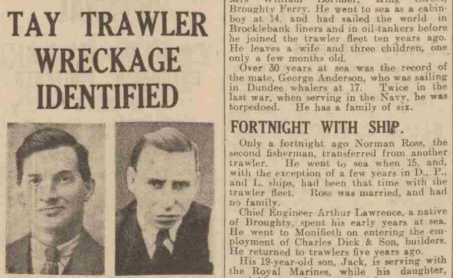It was a tragedy that shook Tayside during the already harrowing Word War Two years.
Seventy-seven years ago on Monday, nine men lost their lives when fishing trawler Ben Attow picked up a mine in the Firth of Forth.
A total of 26-children — most from Dundee — were left fatherless following the “terrific explosion”.
One of them was Peter Schiavetta, who has now spoken out about growing up in the aftermath of the disaster in order to mark the 77th anniversary.
Peter, 81, from Broughty Ferry, said: “It was 1940 and I was only about three or four years old when it happened.
“My father Luigi had his own fish and chip shop in King Street in the Ferry.
“It was only his first or second trip on the trawler, and he was standing in for a guy that fell ill.
“My siblings and I were among the 26 children that were left fatherless.
“There were 10 of us — five girls and five boys. My mother was left on her own to look after us.
“People nowadays talk about poverty, but in those days there was no government help for families.
“We were helped by neighbours and the church. The ten of us lived in two rooms and slept three to a bed, while the babies slept in drawers.
“The toilet was outside and if you wanted to go you had to carry a candle with you.
“They were hard days, but we survived and I think the event is something that is still worth commemorating today.”
Those that died in the Ben Attow tragedy included Luigi Schiavetta, William Lorimer, George Anderson, Norman Ross, Arthur Lawrence, Robert Mayes, W.J. Briggs, John Robertson and Alexander Gall, all men from Broughty Ferry, Monifieth and Tayport.
A total of £422 — around £24,000 in today’s money — was raised to help the dependants of the deceased.
A Courier article from March 5, 1940, stated: “The trawler put to sea last Tuesday and should have returned for the weekend in port.
“On Wednesday the Strathblane, of the same fleet, put in and reported the lights of another vessel, thought to be Ben Attow, disappeared after a terrific explosion late on Tuesday night.
“A representative of Cameron & M’Farlane Ltd, Dundee, managers of the vessel, stated that, following the discovery of the wreckage, they now feared there could be no doubt the trawler had been lost.”
